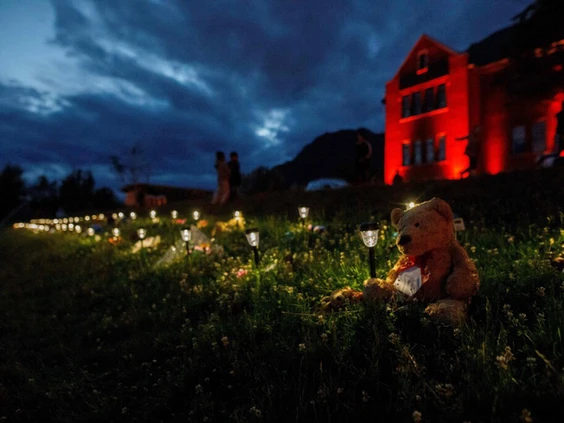In a recent statement, the First Nation announced a Day of Reflection to mark the anniversary of the 2021 announcement

The former Kamloops Indian Residential School where flowers and cards were left as part of a memorial on June 5, 2021. PHOTO BY COLE BURSTON/AFP VIA GETTY IMAGES
Three years after Tk’emlúps te Secwépemc first published the explosive news that they had uncovered the graves of 215 children, the First Nation is now officially referring to the 215 as “anomalies” rather than confirmed graves.
In a recent statement, the First Nation announced a Day of Reflection to mark the anniversary of the 2021 announcement, which quickly garnered headlines around the world, inspired an official Canadian visit from Pope Francis and prompted the federal government to order flags flown at half mast for more than five months.
A prolonged period of public outrage following the announcement would also spark an unprecedented wave of arsons targeting predominantly Indigenous churches. In the summer of 2021, more than 60 Canadian churches would be destroyed, desecrated or vandalized.
The Day of Reflection statement employed almost exactly the same language as in the initial 2021 announcement, except instead of the term “remains of 215 children,” it was now using the term “anomalies.”
“With the help of a ground penetrating radar specialist, the stark truth of the preliminary findings came to light — the confirmation of 215 anomalies were detected,” reads the Day of Reflection statement.
Compare that to the May 27, 2021 announcement from the First Nation: “This past weekend, with the help of a ground penetrating radar specialist, the stark truth of the preliminary findings came to light — the confirmation of the remains of 215 children who were students of the Kamloops Indian Residential School.”
What had been found in 2021 was evidence of soil disturbances. Over the Victoria Day weekend that year, a contractor ran a ground-penetrating radar unit over a field near the former site of the Kamloops Indian Residential School. In 215 places they found soil densities that were different than in the rest of the field.
“It could be a stone under the ground, it could be a clump of clay, it could be a piece of wood or it could be something,” was how Sheldon Poitras — the project lead on a residential school grave search in Saskatchewan — explained the process to CTV in 2023.
In that particular case — which focused on the former site of the Qu’Appelle Indian Residential School — the radar search did occur in the vicinity of where a fragment of bone believed to be a child’s jawbone had been discovered. A subsequent coroner’s analysis determined that it was likely buried around 1900, when Qu’Appelle was recording its highest rates of student of mortality.
But none of the 215 anomalies at Kamloops Indian Residential School have been archaeologically confirmed as graves.
Despite this, not only did widespread media reports in 2021 report the 215 as confirmed burials, but they occasionally called them a “mass grave.”
The New York Times coverage of the Kamloops survey, most notably, put the term “mass grave of Indigenous children” in its headline.
Official T’kemlups statements would avoid the term mass graves — as would other Canadian First Nations who announced similar discoveries throughout the summer of 2021.
However, T’kemlups Chief Rosanne Casimir would include the term “mass graves” in a successful motion passed at a July 2021 meeting of the Assembly of First Nations.
Resolution number 01/2021 stated “the mass grave discovered at the former Kamloops Indian Residential School reveals Crown conduct reflecting a pattern of genocide against Indigenous peoples,” and called on Canadian authorities to establish a “verified list of all known locations of mass graves.”
The 215 had always been announced as “undocumented deaths” unaccounted for by official record-keeping.
But long before the Kamloops anomalies, Indian Residential Schools had been identified for having outsized rates of student mortality, many of whom were buried in onsite graveyards using wooden markers that have since rotted away.
Records meticulously gathered by the Truth and Reconciliation Commission document 51 known deaths at the Kamloops Indian Residential School — although the records conspicuously have no recorded deaths from the early 1900s, when Canadian residential schools were repeatedly being hit with devastating tuberculosis outbreaks.
All told, the 3,200 known child deaths over the course of the Indian Residential School program point to a fatality rate of roughly one in 50, although this rate was much worse in the decades before the First World War.
The aforementioned Qu’Appelle Indian Residential School, for instance, saw the deaths of more than 40 per cent of its students in the first six years after its 1884 opening — a death rate that would prompt scandal even at the time.
https://nationalpost.com/opinion/tkemlups-te-secwepemc-first-nation-graves-kamloops
Arwen~ A book written on this subject. Truth matters, there can be NO reconciliation if lies keep being perpetuated, if residential schools are treated as tried and judged, and subject is not open to discussion or query in light of different reports other than what is touted by MSM, politicians and by some FN.

